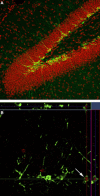Hippocampus-dependent learning influences hippocampal neurogenesis
- PMID: 23596385
- PMCID: PMC3627134
- DOI: 10.3389/fnins.2013.00057
Hippocampus-dependent learning influences hippocampal neurogenesis
Abstract
The structure of the mammalian hippocampus continues to be modified throughout life by continuous addition of neurons in the dentate gyrus. Although the existence of adult neurogenesis is now widely accepted the function that adult generated granule cells play is a topic of intense debate. Many studies have argued that adult generated neurons, due to unique physiological characteristics, play a unique role in hippocampus-dependent learning and memory. However, it is not currently clear whether this is the case or what specific capability adult generated neurons may confer that developmentally generated neurons do not. These questions have been addressed in numerous ways, from examining the effects of increasing or decreasing neurogenesis to computational modeling. One particular area of research has examined the effects of hippocampus dependent learning on proliferation, survival, integration and activation of immature neurons in response to memory retrieval. Within this subfield there remains a range of data showing that hippocampus dependent learning may increase, decrease or alternatively may not alter these components of neurogenesis in the hippocampus. Determining how and when hippocampus-dependent learning alters adult neurogenesis will help to further clarify the role of adult generated neurons. There are many variables (such as age of immature neurons, species, strain, sex, stress, task difficulty, and type of learning) as well as numerous methodological differences (such as marker type, quantification techniques, apparatus size etc.) that could all be crucial for a clear understanding of the interaction between learning and neurogenesis. Here, we review these findings and discuss the different conditions under which hippocampus-dependent learning impacts adult neurogenesis in the dentate gyrus.
Keywords: cell survival; dentate gyrus; hippocampus; memory; neurogenesis; spatial learning.
Figures



Similar articles
-
Strain differences in neurogenesis and activation of new neurons in the dentate gyrus in response to spatial learning.Neuroscience. 2011 Jan 13;172:342-54. doi: 10.1016/j.neuroscience.2010.10.025. Epub 2010 Oct 16. Neuroscience. 2011. PMID: 20955769
-
Adult neurogenesis in the mammalian dentate gyrus.Anat Histol Embryol. 2020 Jan;49(1):3-16. doi: 10.1111/ahe.12496. Epub 2019 Sep 30. Anat Histol Embryol. 2020. PMID: 31568602 Review.
-
Adult hippocampal neurogenesis, synaptic plasticity and memory: facts and hypotheses.Rev Neurosci. 2007;18(2):93-114. doi: 10.1515/revneuro.2007.18.2.93. Rev Neurosci. 2007. PMID: 17593874 Review.
-
Effect of long-lasting serotonin depletion on environmental enrichment-induced neurogenesis in adult rat hippocampus and spatial learning.Neuroscience. 2005;135(2):395-402. doi: 10.1016/j.neuroscience.2005.06.065. Neuroscience. 2005. PMID: 16125851
-
Functional convergence of developmentally and adult-generated granule cells in dentate gyrus circuits supporting hippocampus-dependent memory.Hippocampus. 2011 Dec;21(12):1348-62. doi: 10.1002/hipo.20845. Epub 2010 Sep 7. Hippocampus. 2011. PMID: 20824726
Cited by
-
Brain-wide neuronal activation and functional connectivity are modulated by prior exposure to repetitive learning episodes.Front Behav Neurosci. 2022 Sep 9;16:907707. doi: 10.3389/fnbeh.2022.907707. eCollection 2022. Front Behav Neurosci. 2022. PMID: 36160680 Free PMC article.
-
Gene expression in the amygdala and hippocampus of cyclic and acyclic gilts.J Anim Sci. 2022 Jan 1;100(1):skab372. doi: 10.1093/jas/skab372. J Anim Sci. 2022. PMID: 34984470 Free PMC article.
-
Hippocampal physiology, structure and function and the neuroscience of schizophrenia: a unified account of declarative memory deficits, working memory deficits and schizophrenic symptoms.Behav Sci (Basel). 2013 Jun 21;3(2):298-315. doi: 10.3390/bs3020298. eCollection 2013 Jun. Behav Sci (Basel). 2013. PMID: 25379240 Free PMC article. Review.
-
Thinking after Drinking: Impaired Hippocampal-Dependent Cognition in Human Alcoholics and Animal Models of Alcohol Dependence.Front Psychiatry. 2016 Sep 30;7:162. doi: 10.3389/fpsyt.2016.00162. eCollection 2016. Front Psychiatry. 2016. PMID: 27746746 Free PMC article. Review.
-
Cortical spreading depolarization increases adult neurogenesis, and alters behavior and hippocampus-dependent memory in mice.J Cereb Blood Flow Metab. 2017 May;37(5):1776-1790. doi: 10.1177/0271678X16643736. Epub 2016 Jan 1. J Cereb Blood Flow Metab. 2017. PMID: 27189903 Free PMC article.
References
-
- Altman J., Das G. D. (1965). Autoradiographic and histological evidence of postnatal hippocampal neurogenesis in rats. J. Comp. Neurol. 124, 319–335 - PubMed
LinkOut - more resources
Full Text Sources
Other Literature Sources

